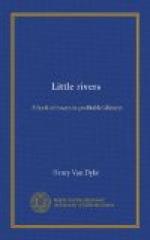and follow its brimming waters through the budding forests, to that corner which we call the Painter’s Camp. See how the banks are all enamelled with the pale hepatica, the painted trillium, and the delicate pink-veined spring beauty. A little later in the year, when the ferns are uncurling their long fronds, the troops of blue and white violets will come dancing down to the edge of the stream, and creep venturously out to the very end of that long, moss-covered log in the water. Before these have vanished, the yellow crow-foot and the cinquefoil will appear, followed by the star-grass and the loose-strife and the golden St. John’s-wort. Then the unseen painter begins to mix the royal colour on his palette, and the red of the bee-balm catches your eye. If you are lucky, you may find, in midsummer, a slender fragrant spike of the purple-fringed orchis, and you cannot help finding the universal self-heal. Yellow returns in the drooping flowers of the jewel-weed, and blue repeats itself in the trembling hare-bells, and scarlet is glorified in the flaming robe of the cardinal-flower. Later still, the summer closes in a splendour of bloom, with gentians and asters and goldenrod.
You never get so close to the birds as when you are wading quietly down a little river, casting your fly deftly under the branches for the wary trout, but ever on the lookout for all the various pleasant things that nature has to bestow upon you. Here you shall come upon the cat-bird at her morning bath, and hear her sing, in a clump of pussy-willows, that low, tender, confidential song which she keeps for the hours of domestic intimacy. The spotted sandpiper will run along the stones before you, crying, “wet-feet, wet-feet!” and bowing and teetering in the friendliest manner, as if to show you the way to the best pools. In the thick branches of the hemlocks that stretch across the stream, the tiny warblers, dressed in a hundred colours, chirp and twitter confidingly above your head; and the Maryland yellow-throat, flitting through the bushes like a little gleam of sunlight, calls “witchery, witchery, witchery!” That plaintive, forsaken, persistent note, never ceasing, even in the noonday silence, comes from the wood-pewee, drooping upon the bough of some high tree, and complaining, like Mariana in the moated grange, “weary, weary, weary!”
When the stream runs out into the old clearing, or down through the pasture, you find other and livelier birds,—the robins, with his sharp, saucy call and breathless, merry warble; the bluebird, with his notes of pure gladness, and the oriole, with his wild, flexible whistle; the chewink, bustling about in the thicket, talking to his sweetheart in French, “cherie, cherie!” and the song-sparrow, perched on his favourite limb of a young maple, dose beside the water, and singing happily, through sunshine and through rain. This is the true bird of the brook, after all: the winged spirit of cheerfulness and contentment, the patron saint of little rivers,




